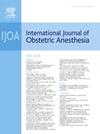选择性剖宫产脊髓麻醉后血清素综合征1例报告
IF 2.3
3区 医学
Q2 ANESTHESIOLOGY
引用次数: 0
摘要
围手术期血清素综合征很难识别,由于各种临床特征可能模仿麻醉师所熟悉的情况,其诊断可能具有挑战性。大多数围手术期血清素综合征的病例都是在术后发生的,在剖腹产期间没有发生。我们描述了一个不寻常的情况下,术中血清素综合征,发展后立即脊髓麻醉的病人接受选择性剖腹产。患者在麻醉时服用舍曲林,出现发热、出汗、自发性强直、心律失常发作,无反应,进入围骤停期。我们假设可能的机制,包括阿片类药物的作用,鞘内布比卡因和急性应激可能导致血清素综合征的发作。该病例强调了早期识别血清素综合征及其在产科患者中的表现的重要性。本文章由计算机程序翻译,如有差异,请以英文原文为准。
Serotonin syndrome following spinal anaesthesia for elective caesarean delivery: a case report
Serotonin syndrome during the perioperative period is difficult to recognise, and its diagnosis can be challenging due to the variety of clinical features that may mimic more familiar conditions known to anaesthetists. Most cases of serotonin syndrome in the perioperative setting have been reported in the postoperative period, with none occurring during a caesarean delivery. We describe an unusual case of intraoperative serotonin syndrome that developed immediately following spinal anaesthesia in a patient undergoing an elective caesarean delivery. The patient, who was taking sertraline at the time of anaesthesia, developed pyrexia, diaphoresis, spontaneous rigidity, episodes of arrhythmias, became unresponsive and went into peri-arrest. We postulate plausible mechanisms, including the role of opioids, intrathecal bupivacaine, and acute stress that may have contributed to the onset of serotonin syndrome. The case underscores the importance of early identification of serotonin syndrome and its presentation in obstetric patients.
求助全文
通过发布文献求助,成功后即可免费获取论文全文。
去求助
来源期刊
CiteScore
4.70
自引率
7.10%
发文量
285
审稿时长
58 days
期刊介绍:
The International Journal of Obstetric Anesthesia is the only journal publishing original articles devoted exclusively to obstetric anesthesia and bringing together all three of its principal components; anesthesia care for operative delivery and the perioperative period, pain relief in labour and care of the critically ill obstetric patient.
• Original research (both clinical and laboratory), short reports and case reports will be considered.
• The journal also publishes invited review articles and debates on topical and controversial subjects in the area of obstetric anesthesia.
• Articles on related topics such as perinatal physiology and pharmacology and all subjects of importance to obstetric anaesthetists/anesthesiologists are also welcome.
The journal is peer-reviewed by international experts. Scholarship is stressed to include the focus on discovery, application of knowledge across fields, and informing the medical community. Through the peer-review process, we hope to attest to the quality of scholarships and guide the Journal to extend and transform knowledge in this important and expanding area.

 求助内容:
求助内容: 应助结果提醒方式:
应助结果提醒方式:


